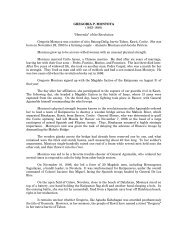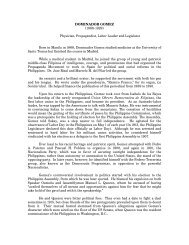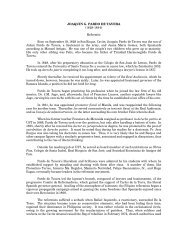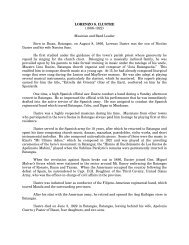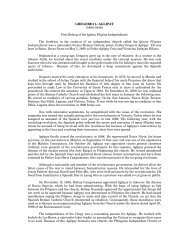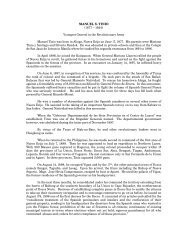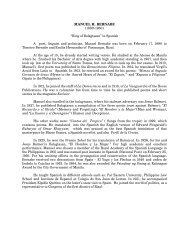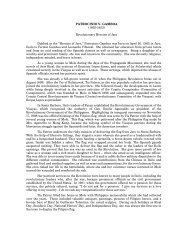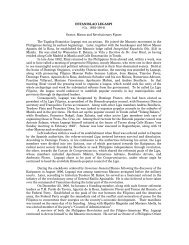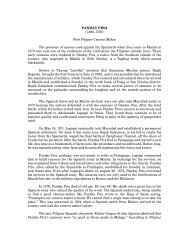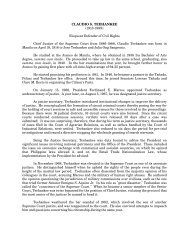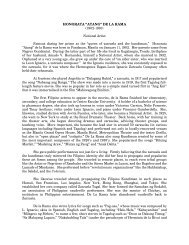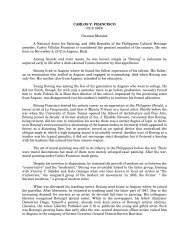CARMEN V. DE LUNA - National Historical Commission of the ...
CARMEN V. DE LUNA - National Historical Commission of the ...
CARMEN V. DE LUNA - National Historical Commission of the ...
You also want an ePaper? Increase the reach of your titles
YUMPU automatically turns print PDFs into web optimized ePapers that Google loves.
<strong>CARMEN</strong> V. <strong>DE</strong> <strong>LUNA</strong><br />
(1873-1962)<br />
“Educator’s Educator”<br />
A model educator and philanthropist, Carmen de Luna devoted more than 60 years <strong>of</strong><br />
her life to <strong>the</strong> education <strong>of</strong> <strong>the</strong> Filipino youth. Her long, continuous, and untiring service in <strong>the</strong><br />
field <strong>of</strong> education earned her <strong>the</strong> distinction as <strong>the</strong> “educator’s educator.”<br />
Born in San Miguel, Manila on July 16, 1873 to Sebastian de Luna and Iglecia Villajuan<br />
<strong>of</strong> Catanawan, Tayabas, she obtained her early education as an interna in <strong>the</strong> private Catholic<br />
School <strong>of</strong> Anacleta Abrera in Binondo. A maestra elemental in a private in 1890, she earned<br />
<strong>the</strong> title <strong>of</strong> maestra superior at <strong>the</strong> Assumption Convent in 1894. She passed <strong>the</strong> government<br />
examination for a teaching license in <strong>the</strong> same year.<br />
In 1907, <strong>the</strong> year she completed her bachelor <strong>of</strong> arts and science degree, she became one<br />
<strong>of</strong> <strong>the</strong> co-founders <strong>of</strong> Centro Escolar de Señoritas. She worked hard to improve <strong>the</strong> quality <strong>of</strong><br />
teaching in <strong>the</strong> <strong>the</strong>n already internationally recognized institution. When <strong>the</strong> educational<br />
system under <strong>the</strong> American rule included English as part <strong>of</strong> <strong>the</strong> school curriculum, she sailed<br />
with Librada Avelino to Hong Kong where <strong>the</strong>y took up English courses. Upon his return, <strong>the</strong>y<br />
pioneered in <strong>the</strong> teaching <strong>of</strong> English at Centro Escolar.<br />
With <strong>the</strong> death <strong>of</strong> Avelino in 1934, Miss De Luna assumed <strong>the</strong> presidency <strong>of</strong> Centro<br />
Escolar. Although she was a strict disciplinarian, she was never<strong>the</strong>less well loved “for tempering<br />
discipline with justice” and for caring deeply for her fellowmen. She held <strong>the</strong> highest position at<br />
that institution from 1934 until her death on November 4, 1962.<br />
Lovingly known as Maestra Mameng, De Luna was actively involved in civic, religious,<br />
and charitable work. She was a member <strong>of</strong> <strong>the</strong> Liga de Mujeres; La Gota de Leche, an<br />
orphanage; Oblates <strong>of</strong> <strong>the</strong> Nuestra Señora de Monserrat in San Beda College; C<strong>of</strong>radia de<br />
Nuestra Señora del Carmen, and <strong>the</strong> C<strong>of</strong>radia de San Jose Recoletos. She served as president <strong>of</strong><br />
<strong>the</strong> Asociacion de Sta. Teresita and Santo Entierro <strong>of</strong> <strong>the</strong> Dominican Order. Among <strong>the</strong> many<br />
objects <strong>of</strong> her beneficence were <strong>the</strong> Carmelite sisters in Manila and Lipa City, <strong>the</strong> Good<br />
Shepherd and <strong>the</strong> sisters <strong>of</strong> Sta. Catalina College.<br />
In recognition <strong>of</strong> her philanthropy and civic-mindedness, she received <strong>the</strong> papal award<br />
from Pope Pius XII in 1950, for her religious leadership in Catholicism; gold medal award<br />
during <strong>the</strong> golden jubilee <strong>of</strong> <strong>the</strong> Philippine Educational System, for her enduring contributions<br />
in <strong>the</strong> field <strong>of</strong> private education and for being one <strong>of</strong> <strong>the</strong> founders <strong>of</strong> Centro Escolar University;<br />
award <strong>of</strong> merit from President Quirino on July 13, 1949, for her educational, civic, and social<br />
services to <strong>the</strong> Filipino youth; medal and a diploma <strong>of</strong> merit on November 29, 1950 from <strong>the</strong><br />
Spanish government, for her advocacy <strong>of</strong> <strong>the</strong> study <strong>of</strong> <strong>the</strong> Spanish language and culture in <strong>the</strong><br />
Philippines; and presidential award on March 25, 1961, for her outstanding achievements in<br />
education and civic activities.<br />
On July 16, 1973, <strong>the</strong> <strong>National</strong> <strong>Historical</strong> Institute installed a historical marker in her<br />
honor at <strong>the</strong> CEU building on Mendiola Street, San Miguel, Manila.<br />
References.
Ancheta, Herminiana M. and Michaela Beltran-Gonzalez, Filipino Women in Nation Building,<br />
Phoenix Press, Inc. Quezon City, 1984.<br />
Cornejo, M.R. Commonwealth Directory <strong>of</strong> <strong>the</strong> Philippines, 1939.<br />
Varias,-de Guzman, Jovita, Ed. Women <strong>of</strong> Distinction : Biographical Essay on Outstanding<br />
Filipino Women <strong>of</strong> <strong>the</strong> Past and <strong>the</strong> Present. Philippines : Bukang Liwayway, 1967.



